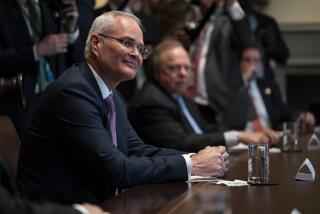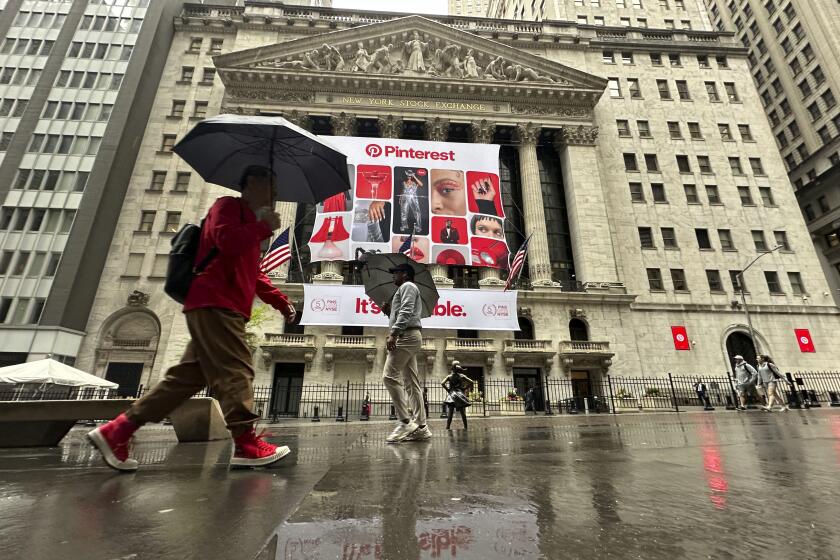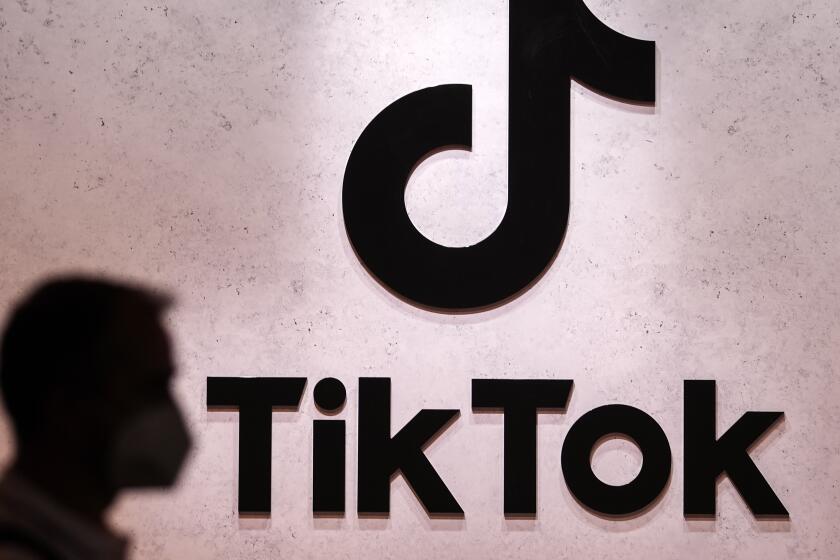Builders Complain Warner Center Plan Is Too Restrictive : Development: Firms say new density restrictions and traffic fees could scuttle their projects.
Warner Center rose out of cornfields two decades ago to become the San Fernando Valley’s answer to Century City. Today, the Woodland Hills business center is home to several high-rise office buildings, two hotels and two shopping malls. With a total of 14.4 million square feet of commercial space spread over 1,100 acres, it is already larger than its Westside counterpart.
Developers have numerous large projects in mind that would complete Warner Center’s transformation over the next 10 to 15 years into a city-within-a-city rivaling downtown Los Angeles as a prestige business address.
But some of those developers now worry that these projects might never be built. Why? Last week, the long-awaited proposal for updating the center’s master plan was released by Los Angeles city planners. On the surface, the plan appears generous to developers, providing for nearly doubling the square footage to 26.8 million. Developers argue, however, that the plan would actually severely restrict some of their projects.
If adopted as written, they contend, the plan would substantially limit future development in Warner Center by reducing available densities and imposing stiff fees on developers to help control the additional traffic new buildings would generate.
“It would have a dire effect on our property,” said Craig Cahow, vice president of Trizec Warner Inc.
Trizec, a subsidiary of Trizec Corp. Ltd., a Canadian developer, paid $60 million in January, 1990, for 21 acres in Warner Center, including the four-story headquarters building of computer printer-maker Dataproducts Corp. Trizec hopes to build four six-story buildings at the site.
Other developers with projects planned in Warner Center include JMB/Urban Development Co. and LaSalle Partners, two large Chicago-based firms, and May Centers Inc., jointly owned by St. Louis-based May Department Stores Co. and Prudential Insurance Co. of Newark, N. J. All together, the proposals would add about two dozen office buildings and a new hotel, and expand both shopping malls.
The Voit Cos., Warner Center’s biggest landlord with about 3 million square feet of office space, has not announced plans for new projects in Warner Center.
All the proposed projects are on hold, awaiting the adoption of a final development plan by the city. Meanwhile, the developers say their costs are mounting while they wait--from interest payments on undeveloped land to the possible loss of tenants who might depart Warner Center if their expansion needs can’t be met.
If a compromise can’t be reached between the developers and the city, “they’ll all sue,” predicted Seth Dudley, who manages the Valley office of Julien J. Studley Inc., a New York-based commercial real estate broker.
The creation of Warner Center dates back to the late 1960s, when the first office buildings broke ground on the former ranch of the Warner family, the founders of Warner Bros. studios. The center is bounded by Vanowen Street on the north, Topanga Canyon Boulevard on the west, De Soto Avenue on the east and the Ventura Freeway on the south.
Those developers with projects planned say the proposed master plan would impose strict limits on growth. For example, JMB and Blue Cross of California want to erect eight office buildings on 32 acres surrounding Blue Cross headquarters. But because the city’s plan would cut back the density allowed for each project, JMB would be forced to take 400,000 square feet out of its proposed 2.4-million-square-foot development.
O’Connor Group, a New York-based developer that plans a 2.9-million-square-foot office complex and expansion of the Promenade Mall, would have to reduce its project by 12.5%. An office and hotel development proposed by May Centers would be scaled back by as much as 30%.
But what has developers most worried is the traffic fees. Under the new plan, developers would be charged $14,990 for each estimated new car trip their projects would generate per day. These “trip fees” are about three times the comparable fees paid by developers under the Ventura Boulevard Specific Plan.
John Lyda, development director for May Centers, said the trip fees for the proposed expansion of the Topanga Plaza shopping mall would amount to about $47 per square foot--more than half the $90-per-square-foot cost of construction. “If we had to pay that, could we build? We don’t know, but our guess is no,” he said.
John Matthews, vice president of JMB/Urban, said his company would have to pay about $60 million in trip fees for its proposed project, which would wipe out the 10% return on investment developers typically hope to earn. If JMB tried to pass the costs on to tenants, it would mean boosting rents by about $2.50 from the $20 to $25 per square foot now charged for office space in Warner Center, he said.
Would prospective tenants pay that much? “That’s what we’re most concerned about,” Matthews said.
Meanwhile, some developers worry that it could be years before a plan is finalized. City officials say the plan will be open to public discussion during the next few months. If approved by the mayor and City Council, a final plan would be implemented in July, 1992. But Lyda said that the timetable is optimistic and that it could be two years before a plan is adopted.
These delays can be expensive. Trizec, for example, paid $60 million for its 21 acres. That means it has shelled out roughly $9 million in interest so far, a sum only partially offset by Dataproducts’ rent payments. “The longer it goes, the deeper the hole gets,” Cahow said. “At some point, we have to ask, ‘Can we extricate ourselves from this?’ ”
May Centers, by comparison, has lower operating costs because it bought its Warner Center property in the 1960s, and it also collects rents for Topanga Plaza. Similarly, O’Connor Group has revenue coming in from the Promenade Mall, which it acquired in 1989 for an undisclosed amount.
Developers also worry that if they can’t build because the master plan is too restrictive, Warner Center will begin to lose major tenants. Already, Health Net, the state’s second-largest health maintenance organization, has announced plans to move from Warner Center to Thousand Oaks by 1994 to accommodate its growing work force.
Another large Warner Center tenant, insurance holding company 20th Century Industries, occupies a building owned by May Centers and has said it needs another building by 1993. Lyda said May Centers could provide the new building, but now he’s worried that the 1993 deadline will be missed and the insurer will leave Warner Center.
Mike Pecar, O’Connor’s vice president in charge of development in California, said he is afraid that existing properties will suffer if new development is curtailed.
“We’re very concerned that if the Promenade Mall can’t expand that it will lose its market over time, that it won’t be able to compete,” Pecar said.
The controversy over the city’s Warner Center plan comes at a time when developers are struggling to get buildings off the ground even without local growth curbs. Office vacancy rates nationwide have skyrocketed; the rate in the West Valley--which includes Warner Center--was 22.7% in the second quarter, up from 18.3% in the first quarter, according to the real estate firm Grubb & Ellis. And banks--many of which hold shaky real estate loan portfolios--are no longer willing or able to finance speculative commercial projects.
Of the developers with projects planned in Warner Center, only the O’Connor Group says it has all its financing in place--and that is from a real estate investment trust.
But other developers argue that financing is available for substantially pre-leased projects. They say that demand for office space in Warner Center is strong and that the high vacancy rate in the area is primarily due to Warner Center Plaza 3, a 600,000-square-foot office building that Voit recently completed. There are no other buildings under construction in Warner Center.
Despite their grumblings, many developers say they’re optimistic that a compromise can be reached with the city before a new plan is adopted.
“This is just their first shot out of the box,” Pecar said. “I think the city will study it further.”
Warner Center Projects
Many sizeable commercial real estate projects have been proposed for Warner Center in Woodland Hills. But the projects are on hold while a longterm development plan for Warner Center is studied by city officials. Developers say their projects would have to be revised, or possibly abandoned, if the new plan is adopted because it would cut current building densities, yet boost developer fees for traffic control. Listed below are six of these projects.
* 1. Developer: May Centers Inc.
Project: South of Victory Plan (seven 11-story office buildings, hotel, 160 residential units)
Total Square Feet: 2.2 million*
Estimated Cost: $625 million
* 2. Developer: May Centers Inc.
Project: Topanga Plaza Mall Expansion (add two department stores, plus additional mall space)
Total Square Feet: 750,000
Estimated Cost: $175 million
* 3. Developer: JMB/Urban Development Co. & Blue Cross
Project: Park Square (eight office buildings, 10- to 26-stories each)
Total Square Feet: 2.4 million
Estimated Cost: $600 million
* 4. Developer: O’Connor Group
Project: Promenade Mall Expansion and Office Development (three office buildings, two department stores, additional mall space)
Total Square Feet: 2.9 million
Estimated Cost: $290 million
* 5. Developer: LaSalle Partners
Project: Design Center
Total Square Feet: 540,000 (four 6-story office buildings)
Estimated Cost: Not Available
* 6. Developer: Trizec Warner Inc.
Project: Trizec Centre
Total Square Feet: 545,000 (four 6-story office buildings)
Estimated Cost: Not Available
* Does not include residential







